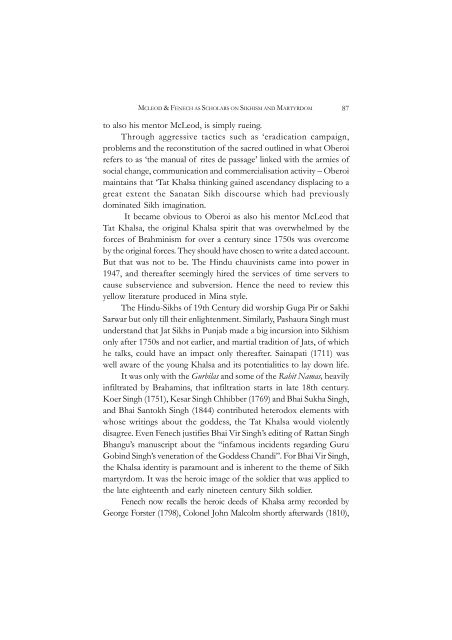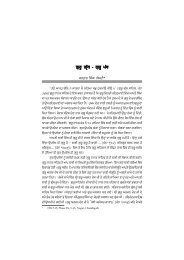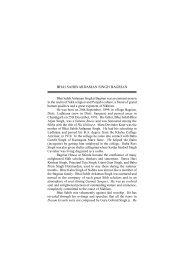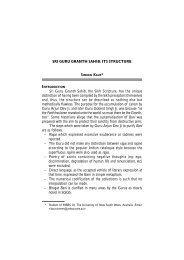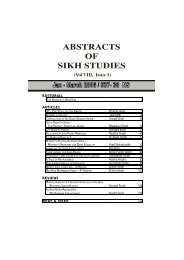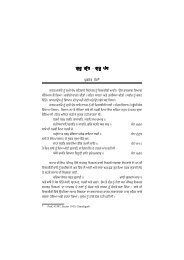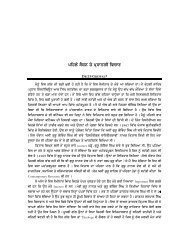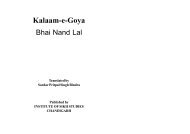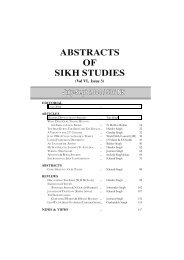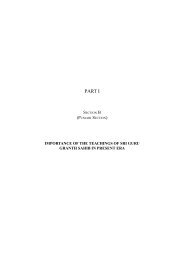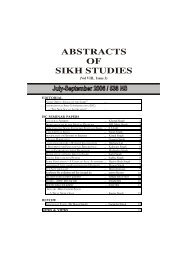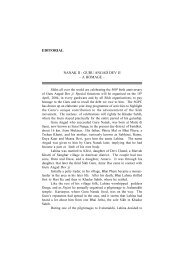editorial articles reviews news & views - Institute of Sikh Studies
editorial articles reviews news & views - Institute of Sikh Studies
editorial articles reviews news & views - Institute of Sikh Studies
Create successful ePaper yourself
Turn your PDF publications into a flip-book with our unique Google optimized e-Paper software.
MCLEOD & FENECH AS SCHOLARS ON SIKHISM AND MARTYRDOM<br />
87<br />
to also his mentor McLeod, is simply rueing.<br />
Through aggressive tactics such as ‘eradication campaign,<br />
problems and the reconstitution <strong>of</strong> the sacred outlined in what Oberoi<br />
refers to as ‘the manual <strong>of</strong> rites de passage’ linked with the armies <strong>of</strong><br />
social change, communication and commercialisation activity – Oberoi<br />
maintains that ‘Tat Khalsa thinking gained ascendancy displacing to a<br />
great extent the Sanatan <strong>Sikh</strong> discourse which had previously<br />
dominated <strong>Sikh</strong> imagination.<br />
It became obvious to Oberoi as also his mentor McLeod that<br />
Tat Khalsa, the original Khalsa spirit that was overwhelmed by the<br />
forces <strong>of</strong> Brahminism for over a century since 1750s was overcome<br />
by the original forces. They should have chosen to write a dated account.<br />
But that was not to be. The Hindu chauvinists came into power in<br />
1947, and thereafter seemingly hired the services <strong>of</strong> time servers to<br />
cause subservience and subversion. Hence the need to review this<br />
yellow literature produced in Mina style.<br />
The Hindu-<strong>Sikh</strong>s <strong>of</strong> 19th Century did worship Guga Pir or Sakhi<br />
Sarwar but only till their enlightenment. Similarly, Pashaura Singh must<br />
understand that Jat <strong>Sikh</strong>s in Punjab made a big incursion into <strong>Sikh</strong>ism<br />
only after 1750s and not earlier, and martial tradition <strong>of</strong> Jats, <strong>of</strong> which<br />
he talks, could have an impact only thereafter. Sainapati (1711) was<br />
well aware <strong>of</strong> the young Khalsa and its potentialities to lay down life.<br />
It was only with the Gurbilas and some <strong>of</strong> the Rahit Namas, heavily<br />
infiltrated by Brahamins, that infiltration starts in late 18th century.<br />
Koer Singh (1751), Kesar Singh Chhibber (1769) and Bhai Sukha Singh,<br />
and Bhai Santokh Singh (1844) contributed heterodox elements with<br />
whose writings about the goddess, the Tat Khalsa would violently<br />
disagree. Even Fenech justifies Bhai Vir Singh’s editing <strong>of</strong> Rattan Singh<br />
Bhangu’s manuscript about the “infamous incidents regarding Guru<br />
Gobind Singh’s veneration <strong>of</strong> the Goddess Chandi”. For Bhai Vir Singh,<br />
the Khalsa identity is paramount and is inherent to the theme <strong>of</strong> <strong>Sikh</strong><br />
martyrdom. It was the heroic image <strong>of</strong> the soldier that was applied to<br />
the late eighteenth and early nineteen century <strong>Sikh</strong> soldier.<br />
Fenech now recalls the heroic deeds <strong>of</strong> Khalsa army recorded by<br />
George Forster (1798), Colonel John Malcolm shortly afterwards (1810),


